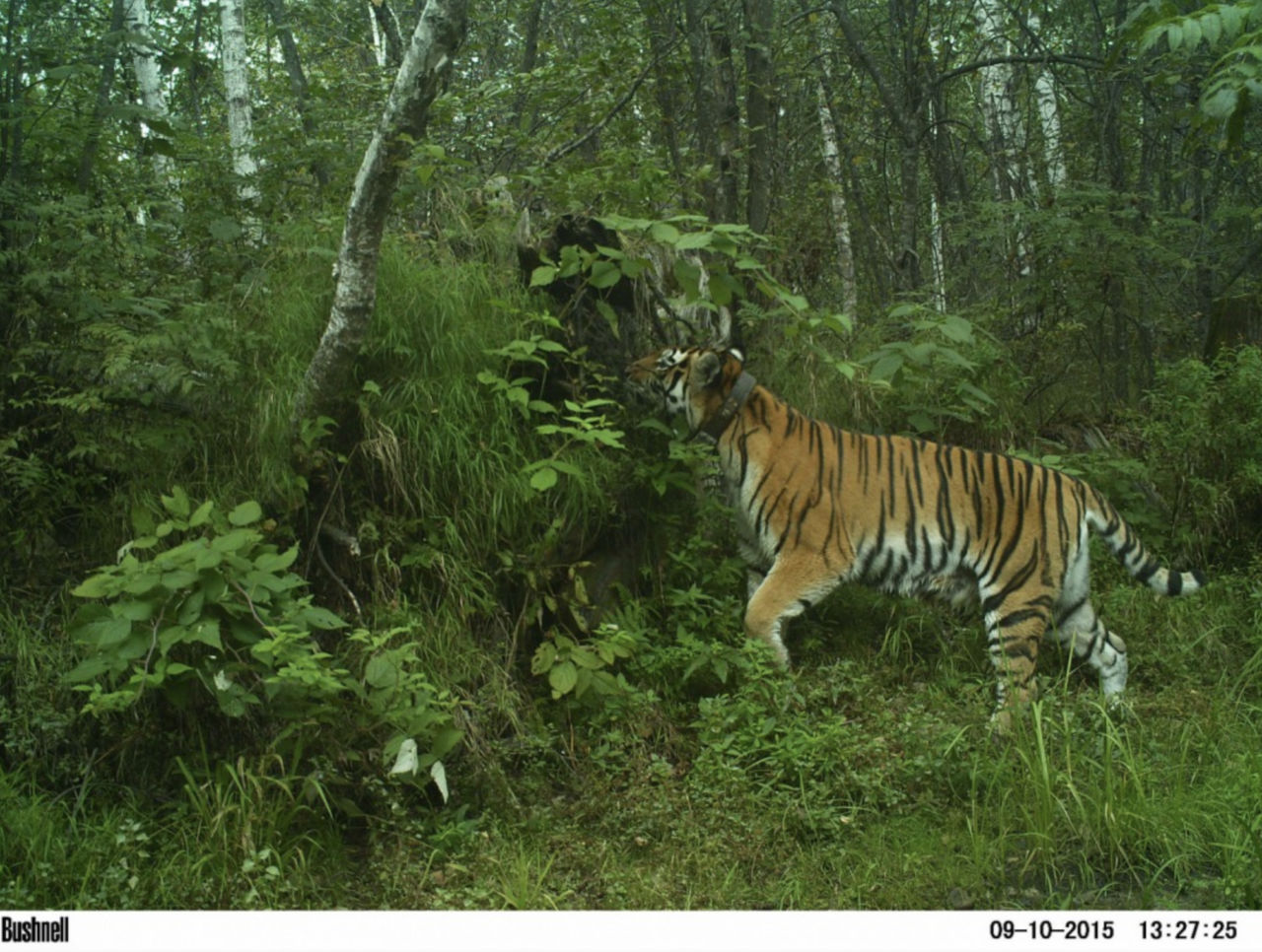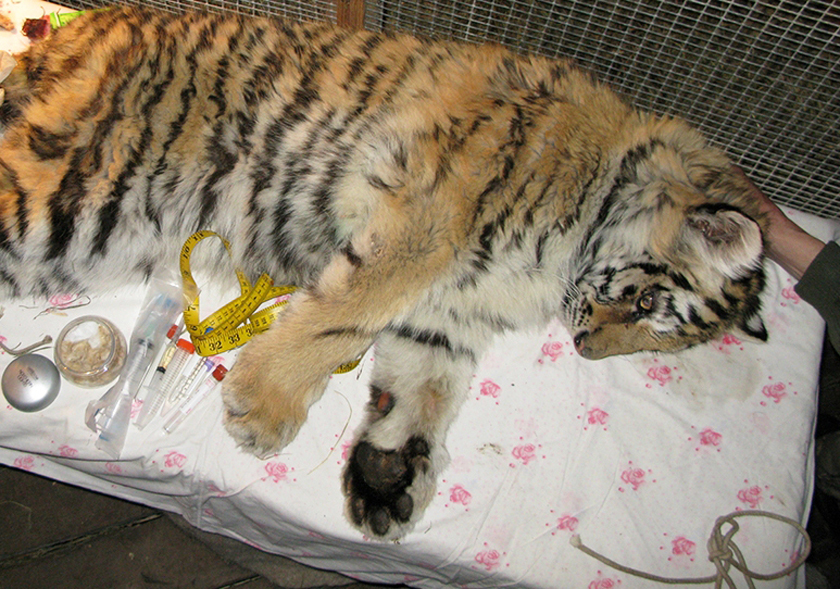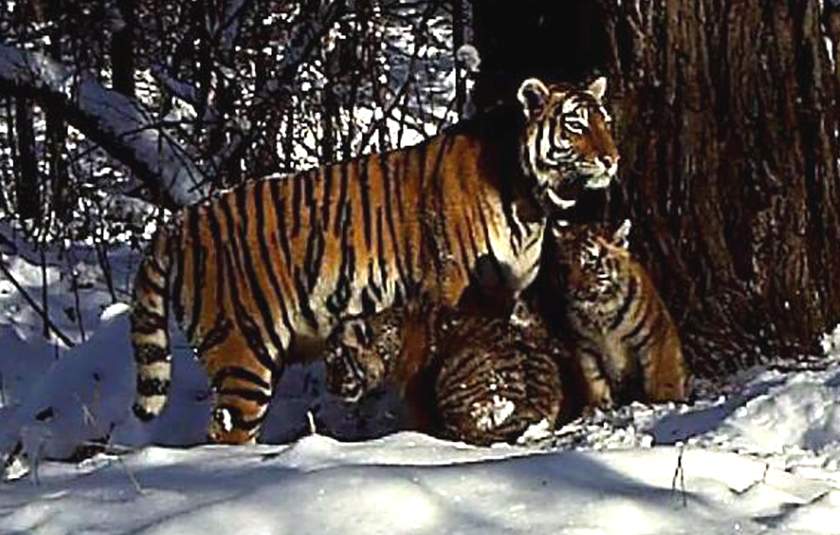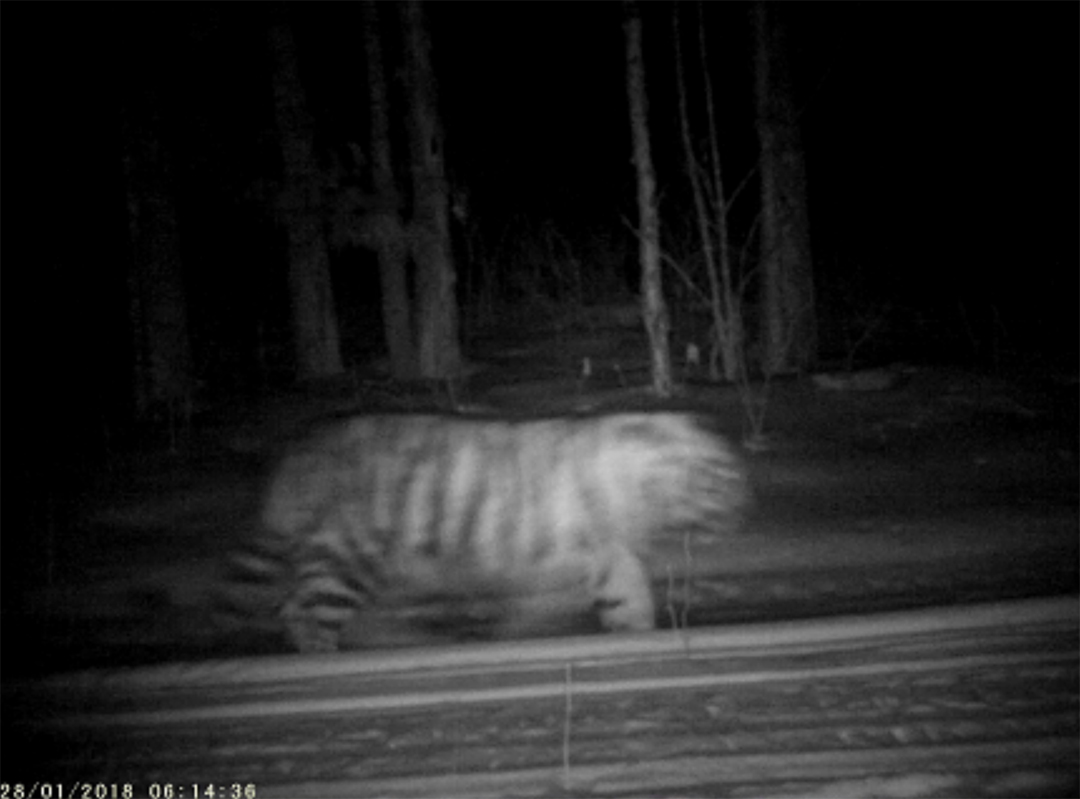Tail Or No Tail, This Tigress Is Thriving
New trail video reveals another milestone for rehabilitated Amur tiger Zolushka: her second litter in the wild.
By Vicki Croke
She is one charismatic and unique cat.
And even if you don’t have a degree in wildlife biology and can’t identify individual tigers by stripe pattern, you stand a good chance of recognizing her, especially if you know her story.
Caught on camera: Zolushka walking a snowy trail followed by a cub who appears to be about five months old. Video courtesy of: Vasiliy Gorobeyko (Yevreiskaya Province Natural Resources Department.)
You’ll see what we mean when you look at the grainy camera trap footage taken in the snowy Russian wilderness of the Bastak Reserve, about two weeks ago. Though we can only see the back end of this tiger for a split second before she disappears out of view, that’s enough to catch sight of the conspicuously abbreviated tail of Zolushka. And the rest of the clip gives us a glimpse of an important development: Zolushka is followed by a second tiger, a heavily furred bruiser of a cub, who appears, according to the experts, to be about five months old.
This means a second litter in wild for Zolushka, the pioneering tigress, who was rescued in 2012 as an orphan, rehabilitated, returned to the wild (minus a length of a frostbitten tail), and, in 2015, became the first rehabbed Amur tiger to give birth in the wild.

Zolushka, seen in a greener season in 2015. Jon Slaght of WCS says, “Here, in the Pri-Amur of Russia, a single translocated tigress (who should have died of starvation and frostbite after her mother was poached) is quietly bringing tigers into a place that had not seen them for decades. Tigers are returning to the Pri-Amur. It’s just an amazing story.” Courtesy: Bastak Reserve.
The footage was posted on Facebook by Vasiliy Gorobeyko (of the Yevreiskaya Province Natural Resources Department), and brought to our attention by Dr. Jonathan Slaght, the Russia and Northeast Asia Coordinator for the Wildlife Conservation Society, a group that has worked with Russian conservationists on tiger programs.
We’ve been following the adventures of Zolushka for a few years. We learned right away that she got her name, which is the Russian equivalent of Cinderella, because her story has a fairytale quality to it. In 2015, we wrote about her rescue as a small cub and details of how she lost most of her tail:
Two hunters found her in the winter of 2012—alone, starving, and frostbitten. She was an almost dead tiger cub—really not much more than a striped bag of bones lying in snow.
She’d been orphaned—her mother probably killed by poachers.
Taking pity on her, the hunters threw a coat over the nearly lifeless cat, and carried her to the local wildlife inspector, who fed and protected her. The official called upon Dale Miquelle, a top cat in the world of tiger biologists, who runs the Russia program for the Wildlife Conservation Society and has been tracking and studying these animals since the early 1990s.

Zolushka was starving, alone, and near death when hunters discovered her and carried her to a wildlife officer. Biologists had to amputate part of her frostbitten tail. Courtesy: WCS.
The 4-month-old tiger was anesthetized and treated, having much of her frostbitten, blackened tail amputated.
Her next stop, a brand-new rehabilitation center, helped her regain her tigerness. Zolushka was treated to a vast outward-bound kind of boot camp in the Russian Far East forest where she had minimal—or no–contact with humans, and maximum exposure to prey animals.
And in May 2013, when it looked like she was ready—tigers leave their mothers at about the age of 18 months, Miquelle says— biologists brought her to the Bastak Nature Reserve in the Russian Far East. The reserve—because of habitat loss and poaching, hadn’t seen tigers in 40 years.

In 2015, we saw these images of Zolushka with her first litter of tiger cubs. Courtesy: Bastak Nature Reserve.
Now better protected, the reserve was just waiting the return of tigers. And Zolushka hit the ground running …
There was evidence right away that she killed and ate a badger, and then shortly after that she brought down a wild boar. Proving she’s a pretty tough, hard-core kind of Cinderella. If she were human, she’d be more comfortable in ice cleats than glass slippers.
A male tiger appeared, furthering the fairytale. Dale Miquelle told us at the beginning of 2015: “Zolushka or Cinderella recently has met her prince, meaning that a male tiger has wandered into this area from quite far away. Somehow he showed up in the same area where Zolushka is. And so the prince has found Cinderella and we found them traveling together.”
We followed up with the next chapter in Zolushka’s life months later when she had her first litter of cubs and it seemed clear that she could serve as a model for tiger conservation everywhere:
The real-life fairy tale of Zolushka the tiger, which we first told you about in January just got even better: The rescued, rehabilitated, and released cat has not only survived in the wild, she’s given birth to two cubs. And she’s raising them in a part of the Russian Far East that had been depleted of tigers for 40 years.
It’s the first time ever that a rehabilitated Amur tiger has given birth in the wild.
Now, from the new 2018 video, we see she’s done it again. Zolushka must have given birth last year.
I asked Jon Slaght what his feelings were as he first viewed this video. “It’s difficult to verbalize the impact of seeing this footage,” Slaght responded. “First of all, it’s a video of a tiger cub plodding along, and you’d have to have a heart of stone to not think that was cute.

Blurry but beautiful: Zolushka’s cub–a second litter!–on 1-28-2018. Courtesy: Bastak Reserve.
More importantly, seeing a tiger cub in the Pri-Amur is incredibly inspiring. The experiment that started with Zolushka—to rehabilitate and release cubs orphaned to poachers—has paid off. There are so few conservation success stories in the world: we’re losing orangutans to palm oil, rhinos to poachers, and Vaquitas to illegal fishing. Yet here, in the Pri-Amur of Russia, a single translocated tigress (who should have died of starvation and frostbite after her mother was poached) is quietly bringing tigers into a place that had not seen them for decades. Tigers are returning to the Pri-Amur. It’s just an amazing story.”

One Response to “Tail Or No Tail, This Tigress Is Thriving”
It is heartening to learn that this rehabilitation strategy can be so fruitful and, I suppose, can be extended to other wild creatures who require rehabbing.
Comments are closed.